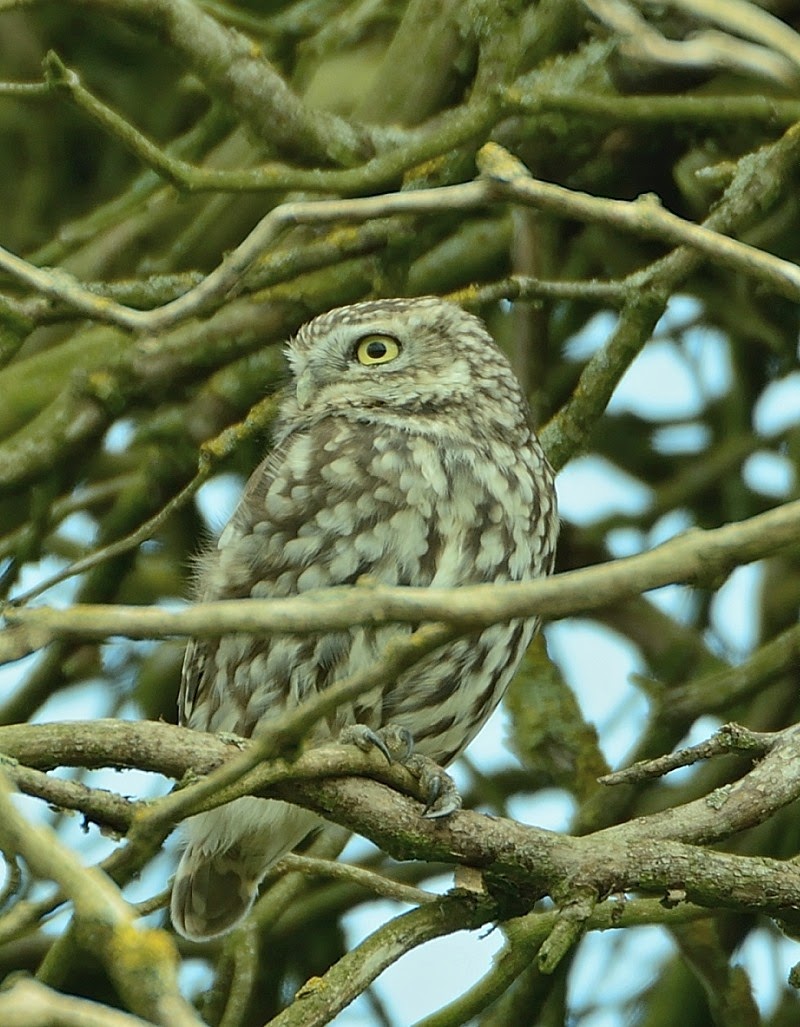OUT AGAIN.
We decided to change our day for going out owling together due to the weather forecast for Thursday not being very good, so Friday became our day, as it happened we should have gone Thursday as the weather was far far better but that's the way of the world.
We started by visiting Little Owl sites on the way out to Rutland Water and the same on our return, and luckily we had far better results with the owls then I did singly last week seeing six in total for the afternoon. This being 2 at site 5, 1 at site 17, 1 at site 12, 1 at site 9 and 1 at site 10 so a great improvement.
On arriving at Rutland Water we have to visit the Egleton Centre and show our passes. The Great White Egret was still on Lagoon 1 but more of that story below. We then set off on our way to the Lagoons to check as to what was present.
Little Owl Site No. 5.
The first site we saw birds at, and thankfully for the first time in a while we saw both birds, one in the hedge on the far side of the field, and one in the nest tree. The farmer had said they heard them most evenings but it was very satisfying to see them for ourselves.
Little Owl Site No.17.
We proceeded from Site 5 to 17 and low and behold Richard immediately saw a bird, again the first time for several weeks. Sat there whilst we took some images and after a few few minutes we set on our way and it still sat and watched us go up the track.
Little Owl Site No 12.
As we approached the site we could see the bird sat with its back towards us under the asbestos coping sheet, so Richard stopped the car and we got a quick image before carrying on our way to Rutland.
Great White Egret Lagoon 1 Rutland Water.
We arrived at the Egleton Centre and as usual went inside to show our passes, and sure enough on the far side of the lagoon, to the left of where I saw the bird last week was the G.W.E. We both had a quick look at the bird through our bins and then Richard was away for ablutions. I had a quick chat to the two volunteers on duty and glanced outside to see the Egret had disappeared. A quick walk to the window and I could see it was flying towards the centre. I ran up the stairs and to the first open window and used the camera and 500mm lens as a point and shoot set up and through some miracle got the above image. It may not be that perfect and I think the camera actually focused on the hedge line and the bird is well to the left but at least I managed a shot of sorts. The bird actually landed on the far side of the hedge in Lagoon 2. A few seconds later a gentleman came up stairs and asked had I seen the Egret, he said he had seen one a couple of weeks previous out the window where he lives, he lives on the ninth floor of a block in Montreal and the bird actually flew past his window and turned and eventually landed in a lake in the Montreal Botanical Gardens. After this we set off towards Lagoon 2 to try and get an image of the elusive bird.
Later in the day we returned to the Egleton Centre having been unable to locate the GWE elsewhere, we think it was behind a large rush bed in Lagoon 2. Two other birders walked in with us and suddenly one said I've found it and sure enough the keen eyed gent had. This time it was slightly closer than last week at 330 metres, but mostly hidden by a bund in the Lagoon.
Lapwing at Lagoon 3 Rutland Water.
Lots of Lapwing are in residence at both Lagoon 3 & 4 and I'm sure elsewhere on the reserve. We met up with one of Richards friends in the hide who told us he had been watching a Peregrine hitting the Lapwings on Lagoon 4 in the morning.
Heron Lagoon 2.
Whilst searching for the GWE on Lagoon 2 we saw this heron and I just had to take a shot.
Harlequin Ladybird, Axyridis Succinea our garden.
These can have up to 17 black spots, so it says in the official information on the species {I think this one has got 19 ???}
These ladybirds are called Harlequin because of the wide range of colours they occur in. They are native to Asia but were introduced into North America and Europe and somehow have made it here.
They are really bad news to our native species by cannibalism but they are also are carrying a very nasty S.T.D. which scientists think may spread to our native ladybird.
Harlequin Ladybird Axyridis Conspicua.
Thank you for visiting my blog, feel free to leave a comment.











No comments:
Post a Comment